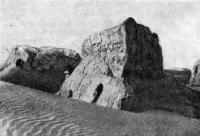You are here
Kumbaskan-kala fortress.

New tourist routes of Karakalpakstan.
“Kum-Baskan makes an amazing impression from the air. A huge castle with mighty towers and a double rectangle of high clay walls is crushed in the full sense by the giant waves of dunes that swept over it."
Tolstov S.P. “In the footsteps of the ancient Khorezm civilization.
Ancient fortresses of Karakalpakstan.
The Kum-Baskan kala fortress ("Fortress covered with sands") is located 17.9 kilometers north and slightly east of the Turtkul village, 23.5 kilometers east and slightly north of the Beruni village in the Ellikkala region of the Republic of Karakalpakstan.
The area of Kumbaskan Kala is 110 x 115 meters, there are 5 defensive minarets on each wall. The walls of the fortress were up to 10 meters high, of which 8 meters have survived to this day. The base of the minarets is 13 x 10.5 meters.
The minarets were two-storied and to establish their true height requires careful scientific research. The fortress was built of clay and mud bricks. Some parts of the fortress are built of bricks, measuring 37 x 37 x 9 (8). On the upper part of the fortress there are dozens of augers for defense.
The augers are 12 - 15 cm wide and 60 cm high. The augers are parallel along the top of the wall. The defensive system of this fortress is distinguished by the fact that the entrances to the minarets are located opposite the entrances to the fortress, i.e. to enter the minaret without falling into the eyes of the enemy.
Donjon is a tall building and the height of the walls covered it. The fortress consisted of several rooms, and one of these rooms was covered with a dome. During the defense of the fortress, minarets, located every 30 meters, played an important role.
Many defensive points are adapted for approaching walls and protecting the wall from enemies. The settlements are densely located around Kumbaskan Kala. Artisans lived here at the time of the Kangyuis (IV century BC - I century AD), the Kushans (I - III centuries AD).
Household utensils, red-treated jugs, beads, antique figures, bronze arrowheads, prints and other household items were found here. Life in the fortress was in full swing until the 7th - 8th centuries. During the invasion of the Arabs led by Kuteiba, the fortress was destroyed.
Geographic coordinates of the Kum-Baskan kala fortress: N41 ° 43'42.06 "E61 ° 01'39.56"
Authority:
http://sovminrk.gov.uz
Photo from the book:
"In the footsteps of the ancient Khorezm civilization." Tolstov S.P. 1948.







